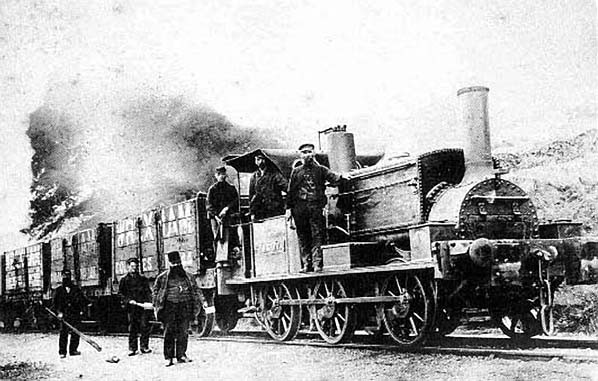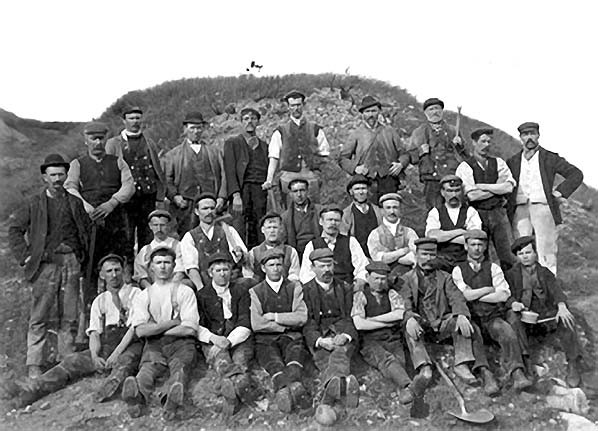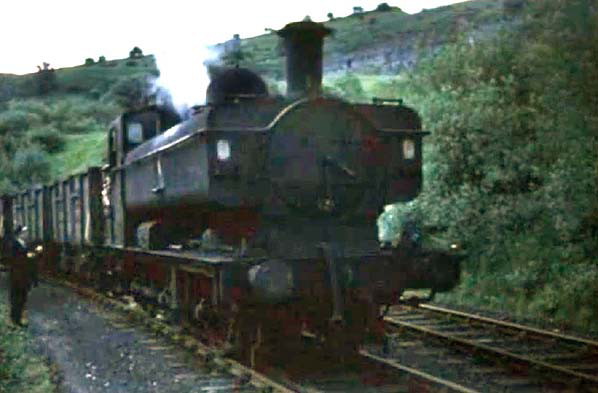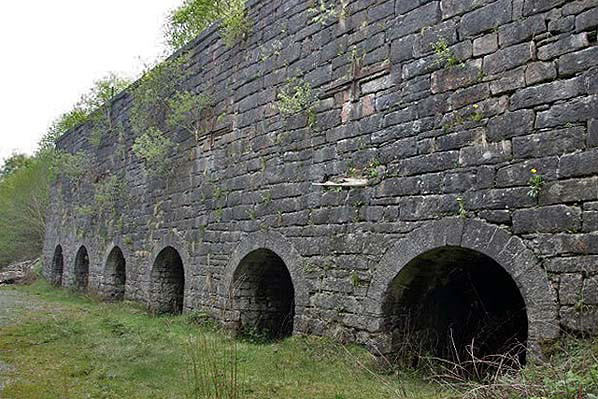 The lime works at Minera looking west in 1910. The picture clearly illustrates the scale of the operations at Minera at that time.
The lime works at Minera looking west in 1910. The picture clearly illustrates the scale of the operations at Minera at that time.
|
The Minera area has been mined for centuries; indeed the unusual name comes from the Latin, meaning ‘mine’ or ‘mining rights’, and has been in use from as early as 1339. The North Wales Mineral Railway reached the area with a line from Wheatsheaf Junction, on the Chester & Shrewsbury Railway to the north of Wrexham, in July 1847. The line was built to facilitate the movement of minerals from Minera, Brymbo and the Moss Valley as well as to serve iron works in the Brymbo area. The line was steeply graded between Wheatsheaf Junction and Brymbo and included two tunnels and two rope-worked inclined planes.
At Minera the line ended at a Lime Works which, with the coming of the railway, was able to expand. Kilns were constructed around about 1850 to convert quarried limestone into lime for industrial purposes. In 1852 the Minera Limeworks Company and the Lester Limeworks were operating at Minera, and by 1859 the railway was carrying 200,000 tons of lime per year away from the works. Both companies had their own private sidings which connected to a goods station; the Minera company’s sidings were able to hold 44 wagons, whilst Lester’s could accommodate only four.
 One the the private locomotives of the Minera Limeworks Company is seen positioned for a photograph within the works at Minera. Its train crew and shunters had all gathered for the photographer. The locomotive was hauling coal waggons. The coal would have been brought to Minera over the Wrexham and Minera branch by the Great Western Railway. It was used as part of the lime making process. At this time the single track line to Brymbo would have been operating at near capacity with coal trains coming into Minera and lime going out.
One the the private locomotives of the Minera Limeworks Company is seen positioned for a photograph within the works at Minera. Its train crew and shunters had all gathered for the photographer. The locomotive was hauling coal waggons. The coal would have been brought to Minera over the Wrexham and Minera branch by the Great Western Railway. It was used as part of the lime making process. At this time the single track line to Brymbo would have been operating at near capacity with coal trains coming into Minera and lime going out.
|
By the 1860s the rope-worked inclined planes seriously impeded the efficient transfer of goods. To enable locomotives to operate throughout, the Wrexham & Minera Railway was opened from Croes Newyyd, south of Wrexham, to Brymbo on 22 May 1862. In 1867 the Minera Lime Company purchased its own locomotive which they named Minera. The loco was required to shunt and haul the ore to the Minera weighbridge from where it was dispatched down the line to Wrexham. By this time trains were being operated by the Great Western Railway (GWR) who had taken over the line. The Minera Limeworks Company had its own water tower at the works for its locomotive but the GWR was allowed to use it; the GWR owned the weighbridge.
The construction of the first 'Hoffman Kiln' was undertaken in 1868. The Minera Lime Company carried out the first of many 'big blasts' in 1872, and following one of these blasts bones, thought to be prehistoric, were found.
 Minera Lime Works as shown on a 1912 map
Minera Lime Works as shown on a 1912 map |
In 1873 there was a derailment at the Minera works involving the locomotive Minera. It came off the track whilst crossing the 'crusher bridge' within the works, and fell onto a track below. Both the driver and another workman were killed in the incident.
A 'big blast' took place at Lester's Limeworks, Minera, at 3pm on 10 May 1884. The rock face selected for blasting was 300 ft long and similar in height. Tunnels 60 ft in length had been driven into the face and these were 180 ft apart. 20 cwt of explosives were packed in one tunnel and 23 cwt into the other. A dull roar and a dust cloud were followed by a shower of small rocks as 23,000 tons of rock face had been blasted away.
By 1887 three loaded trains per day were leaving the limeworks and the Minera Limeworks Company owned 212 of their own railway wagons. In 1894 the Minera Lime Company organised the first of many outings for 152 of its workforce, with a trip to Liverpool at a cost of 1s 9d for each rail fare. This was possibly the first time that a passenger service operated from Minera. In later years workers enjoyed trips to Rhyl, Llandudno & Barmouth. The Lime Company enjoyed a good relationship with its workforce and never experienced any strike action from their employees throughout its existence.
 In the early years of the 20th century a train of lime is seen departing from Minera.
In the early years of the 20th century a train of lime is seen departing from Minera.

Quarrymen at Minera in the early 20th century.
|
A private branch line of about one mile in length was opened from the goods station at Minera to New Brighton, where a lead mine was located. Trains travelling up from the mine had to run into the goods station, and a reversal was necessary for them to go onto the line to Wrexham. As they would have come up the branch using private works locomotives this did not matter as it would be GWR motive power that hauled them away to Wrexham.
In 1899 the Lester and Minera companies amalgamated as the Minera Lime Company. In 1901 the firm quarried 125,000 tons of limestone. During 1904 a cave was discovered after blasting at Minera Lime Works which contained a human skeleton and other bones. British Museum officials who visited the site declared that ‘there is little doubt that these remains are indeed prehistoric’. By this time the works had numerous locomotives and hundreds of wagons.
In 1910 the New Brighton lead mine closed and the branch that served it was lifted.
The very last 'big blast' took place at Minera in 1919. In the 1920s the New Brighton branch was re-laid to serve newly opened silica clay beds. It remained in use for several years before closing once again.
 |
In 1926 the workers at the Minera Lime Works became unemployed as no lime was burned owing to the coal miners’ strike, and by 1932 a general depression in trade resulted in the Minera Lime Works ceasing to operate. The following year the Minera Limeworks Company finally closed.
On 6 September 1952 a railtour organised by the Stephenson Locomotive Society visited Minera. Adam |
Lythgoe Ltd took over the Minera Limeworks site in 1954, and operations were re-commenced.
On the 18 April 1959 another railtour visited the goods station at Minera. Once again organised by the Stephenson Locomitive Society as the Wrexham and District rail tour the train terminated adjacent to the start of the New Brighton branch, which photographs taken at the time of the visit show to be in situ.
Once the largest lime workings in north Wales, the Minera Limeworks closed in 1972. In total, about eight million tons of high quality limestone had been obtained from Minera, - an average of 80,000 tons per year over 100 years.
Shortly after the limeworks closed the railway between Brymbo West and the works was lifted. Following the limeworks closure, the quarry was worked for road building materials until its closure in 1992. In 2004 the quarry areas were cleared of all standing materials and the area partly levelled. Whilst it is said that the quarry still has viable amounts of lime reserves, a return of quarry operations remains very doubtful.
In 2005 the Minera Quarry Trust was set up with the explicit aim of conserving the former quarry site for the benefit of the public.
Sources:
- British Railway Companies, C. Awdry, 1990, Guild Publishing.
- Clinkers Register of Closed Passenger Stations and Goods Depots in England, Scotland and Wales - 1830 -1970 , C. R. Clinker & J. M. Firth, 1971
- Marcher Railways, by A. Bodlander, M. Hambly, H. Leadbetter, D. Southern & S. Weatherley, 2008, Bridge Books.
- Forgotten Railways - North and Mid Wales, Rex Christiansen, 1976, David & Charles.
- Railway Passenger Stations in Great Britain, M Quick, 2009, RCHS.
- Railway World - February 1987 - The Wrexham & Minera Joint Railway, Rex Christiansen, Ian Allan Publishing.
To see passenger stations on the Wrexham and Minera Railway click on the station name: Plas Power, The Lodge, Brymbo (GWR), Pentresaeson Halt, Coed Poeth, Vicarage Crossing Halt & Berwig Halt
See also Minera History Website
.jpg) On the 18th April 1959 the Stephenson Locomotive Society 'Wrexham and District' rail tour visited Minera. It was not the first passenger service to do so as the lime works companies had organised rail excursions in the early days of the line. A railtour had also visited Minera in 1952.
On the 18th April 1959 the Stephenson Locomotive Society 'Wrexham and District' rail tour visited Minera. It was not the first passenger service to do so as the lime works companies had organised rail excursions in the early days of the line. A railtour had also visited Minera in 1952.
Photo by H C Casserley
.jpg)
The goods station at Minera looking east on the 18th of April 1959 as the 'Wrexham and District Rail Tour' prepares to depart. The lime works was to the rear of the photographer A line can be seen veering off the the right adjacent to the buildigs. This was the New Brighton Branch which originalled served a lead mine. It had closed in 1910 only to re-open in the 1920s to serve clay pits.
.jpg) Looking southeast along the New Brighton branch from Minera on the 18th of April 1959. Looking southeast along the New Brighton branch from Minera on the 18th of April 1959.
Photo by R M Casserley

A goods service prepares to depart from Minera in the 1960s.
.jpg)
The site of the Minera goods station seen looking east in 2008.
Photo by Howard C Harrison

Lime kilns at Minera could still be seen in the 21st century.
Photo by Ted Burgess
.jpg) Looking east at the Minera goods station in April 2012. The building in the distance can also be seen in one of the views above. The line to Wrexham went off to the left of the left of the electricity cable pole seen left of centre beyong the furthest building. The New Brighton branch went off to the right at the same point.
Looking east at the Minera goods station in April 2012. The building in the distance can also be seen in one of the views above. The line to Wrexham went off to the left of the left of the electricity cable pole seen left of centre beyong the furthest building. The New Brighton branch went off to the right at the same point.
Photo by Paul Wright
.jpg) Looking north-west along the New Brighton Branch at Minera in April 2012. Set into the ground can be seen stone sleepers from the original line. Looking north-west along the New Brighton Branch at Minera in April 2012. Set into the ground can be seen stone sleepers from the original line.
Photo by Paul Wright |
To see more pictures of Minera click below.
|

